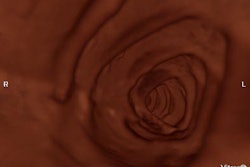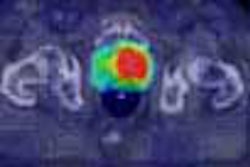NEW ORLEANS - Scanning the coronary arteries has long been a tough nut for newer cardiac imaging modalities such as CT and MRI. However, the relentless march of new technology is extending the reach of these modalities into the coronaries, where motion artifacts can confound older scanners.
In a poster session at this week's American College of Cardiology meeting, a group of German researchers demonstrated that 16-slice scanning has a demonstrable impact on CT's capability to effectively image the coronary arteries at higher heart rates than previously possible with four-slice systems. They believe that 16-slice scanning of the coronary arteries is now possible in over 90% of the population.
Up to now, research on the use of CT in the coronary arteries focused on the four-slice scanners that were the state of the art just a few years ago. Due to artifacts created by the rapid motion of the coronaries, however, four-slice CT was only effective in patients with lower heart rates, in the range of 60-65 beats per minute (bpm), according to Dr. Martin Hoffman of the University of Ulm in Ulm, Germany.
There are a number of technical advantages that 16-slice CT enjoys over four-slice scanning. In addition to a higher slice count, the scanner that the German group used employed a faster gantry rotation speed, of 420 milliseconds (ms) versus 500 ms for the older four-slice system. This advantage gets even better due to the half-scan (180°) reconstruction algorithms typically employed in cardiac imaging -- the temporal resolution of 16-slice CT becomes 210 ms versus 250 ms for four-slice versions, an improvement of nearly 20%.
Hoffman's group used coronary CT angiography in 50 patients with heart rates ranging from 45-103 bpm and who were suspected of having coronary artery disease. The major inclusion criterion for the study was an indication for coronary angiography.
Retrospectively ECG-gated images were reconstructed at pre-selected heart phases (50% and 80% window center in relation to cardiac cycle). The group applied a reconstruction algorithm using a 3-D voxel-based approach with a cardiac phase-weighting function that analyzed the relationship between heart rate, heart-phase reconstruction window, and image quality. Images were then compared to coronary catheterization to assess whether the CTA images could be considered to be free of motion artifacts.
Of the 50 patients, 44 (88%) were considered to have artifact-free images. Not surprisingly, the group found a direct negative correlation between heart rate and image quality. Motion-free images were achieved consistently at or below a heart rate of 80 bpm (n=39), with the best image quality achieved below 75 bpm.
Research indicates that around 90% of the population has a resting heart rate of around 80 bpm. This means that 16-slice imaging of the coronary arteries is now possible in the vast majority of patients.
Hoffman said the research indicates that 16-slice CTA of the coronary arteries is most valuable in the workup of first-time patients who aren't currently undergoing therapy -- these patients typically have an average heart rate of 75 bpm. Patients already undergoing pharmaceutical therapy usually already have resting heart rates below 65 bpm, due to the effectiveness of beta blockers in reducing heart rates. Four-slice CT would be sufficient for these individuals, Hoffman said.
Since the arrival of 16-slice scanners, CT has taken another step forward, with 32-slice, 40-slice, and 64-slice systems. Will these newer scanners offer additional benefits in imaging the coronary arteries?
Most likely, Hoffman said. While gantry rotation speed has a much more profound impact on temporal resolution than slice count, the higher number of slices will reduce breath alteration, which in turn will reduce heart-rate variation and therefore make it easier to reconstruct images. Hoffman's group hopes to replicate its research on one of the new-generation scanners as soon as such a system is acquired by their facility, he said.
By Brian CaseyAuntMinnie.com staff writer
March 8, 2004
Related Reading
Task force recommends against routine coronary heart disease screening, February 17, 2004
CT coronary calcium attenuation affected by body mass, lesion location, January 28, 2004
Sixteen-slice CTA scanning makes everything better, January 5, 2004
Copyright © 2004 AuntMinnie.com




















